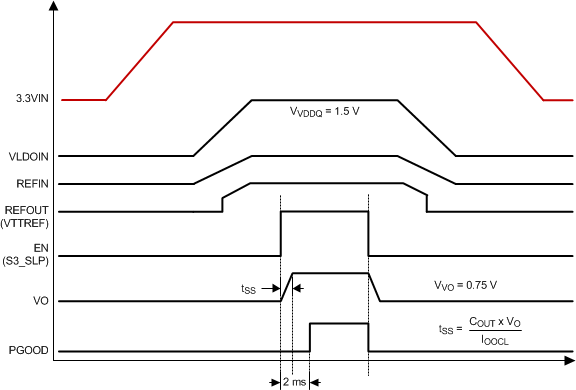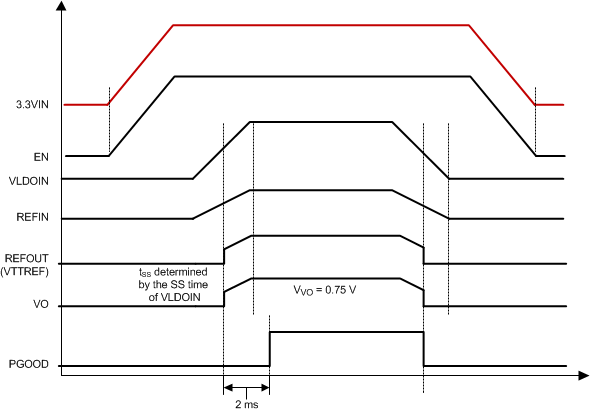SLUS812D February 2008 – February 2020 TPS51200
PRODUCTION DATA.
- 1 Features
- 2 Applications
- 3 Description
- 4 Revision History
- 5 Pin Configuration and Functions
- 6 Specifications
-
7 Detailed Description
- 7.1 Overview
- 7.2 Functional Block Diagram
- 7.3
Feature Description
- 7.3.1 Sink and Source Regulator (VO Pin)
- 7.3.2 Reference Input (REFIN Pin)
- 7.3.3 Reference Output (REFOUT Pin)
- 7.3.4 Soft-Start Sequencing
- 7.3.5 Enable Control (EN Pin)
- 7.3.6 Powergood Function (PGOOD Pin)
- 7.3.7 Current Protection (VO Pin)
- 7.3.8 UVLO Protection (VIN Pin)
- 7.3.9 Thermal Shutdown
- 7.3.10 Tracking Start-up and Shutdown
- 7.3.11 Output Tolerance Consideration for VTT DIMM Applications
- 7.3.12 REFOUT (VREF) Consideration for DDR2 Applications
- 7.4 Device Functional Modes
- 8 Application and Implementation
- 9 Power Supply Recommendations
- 10Layout
- 11Device and Documentation Support
- 12Mechanical, Packaging, and Orderable Information
Package Options
Mechanical Data (Package|Pins)
- DRC|10
Thermal pad, mechanical data (Package|Pins)
- DRC|10
Orderable Information
7.3.10 Tracking Start-up and Shutdown
The TPS51200 also supports tracking start-up and shutdown when the EN pin is tied directly to the system bus and not used to turn on or turn off the device. During tracking start-up, VO follows REFOUT once REFIN voltage is greater than 0.39 V. REFIN follows the rise of VDDQ rail through a voltage divider. The typical soft-start time (tSS) for the VDDQ rail is approximately 3 ms, however it may vary depending on the system configuration. The soft-start time of the VO output no longer depends on the OCL setting, but it is a function of the soft-start time of the VDDQ rail. PGOOD is asserted 2 ms after VVO is within ±20% of REFOUT. During tracking shutdown, the VO pin voltage falls following REFOUT until REFOUT reaches 0.37 V. When REFOUT falls below 0.37 V, the internal discharge MOSFETs turn on and quickly discharge both REFOUT and VO to GND. PGOOD is deasserted when VO is beyond the ±20% range of REFOUT. Figure 20 shows the typical timing diagram for an application that uses tracking start-up and shutdown.
 Figure 19. Typical Timing Diagram for S3 and Pseudo-S5 Support
Figure 19. Typical Timing Diagram for S3 and Pseudo-S5 Support  Figure 20. Typical Timing Diagram of Tracking Start-up and Shutdown
Figure 20. Typical Timing Diagram of Tracking Start-up and Shutdown